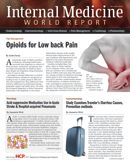Publication
Article
Internal Medicine World Report
Rotational Night Shifts Hazardous to Health
Author(s):
Working more than 3 night shifts per month for years can be hazardous to health, say an international team of researchers

Working the night shift on a rotational basis can be hazardous to health, according to research published in the American Journal of Preventative Medicine.
A global team of researchers investigated the associations between rotating night shift work and all cause of cardiovascular disease (CVD) and cancer mortality. The researchers examined nearly 75,000 registered US nurses from the Nurses’ Health Study, which assesses more than 120,000 female nurses aged between 30-55 years beginning in 1976.
The researchers in the current examination began by reviewing lifetime rotating night shift work, defined as greater than or equal to 3 nights per month, which was collected in 1988. The nurses were categorized by numbers of years worked rotational night shifts into groups: never, 1-2, 3-5, 6-9, 10-14, 15-19, 20-29, and greater than or equal to 30 years.
Over the subsequent 22 years (1988-2010), there were 14,181 reported deaths, including 3,062 CVD and 5,413 cancer deaths. Women with 6-14 years or greater than 15 years of rotating night shift work had an estimated 11% greater rate of all-cause mortality, with CVD mortality at 19 and 23% higher in those groups, respectively. In nurses who worked rotational night shifts for more than 15 years there was a 25% higher risk of lung cancer, though no other cancers were related to an increase of cancer mortality in any other populations.
This study “is one of the largest prospective cohort studies worldwide with a high proportion of rotating night shift workers and long follow up time,” explained Eva S. Schernhammer, MD, DrPH, the corresponding author for this study and Associate Professor of Medicine at Harvard Medical School. “A single occupation — nursing – provides more internal validity than a range of different occupational groups, where the association between shift work and disease outcomes could be confounded by occupational differences.”
In 2007, prior literature urged the World Health Organization to classify night shift work as a probable carcinogen due to circadian disruption, which they did.
“These results add to prior evidence of a potentially detrimental relation of rotating night shift work and health and longevity to derive practical implications for shift workers and their health, the role of duration and intensity of rotating night shift work and the interplay of shift schedules with individual traits (eg, chronotype) warrant further exploration,” concluded Schernhammer, who is also an associate epidemiologist at Brigham and Women’s Hospital.
The researchers also acknowledged the Nurses’ Health Study is one of the largest in the world to include such a large study population, which is one of the advantages and strengths of the study.






